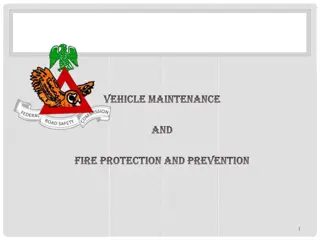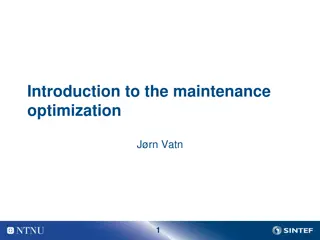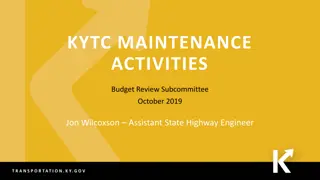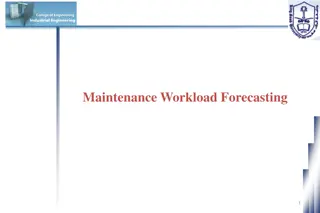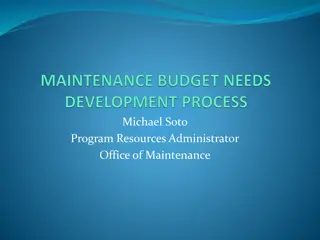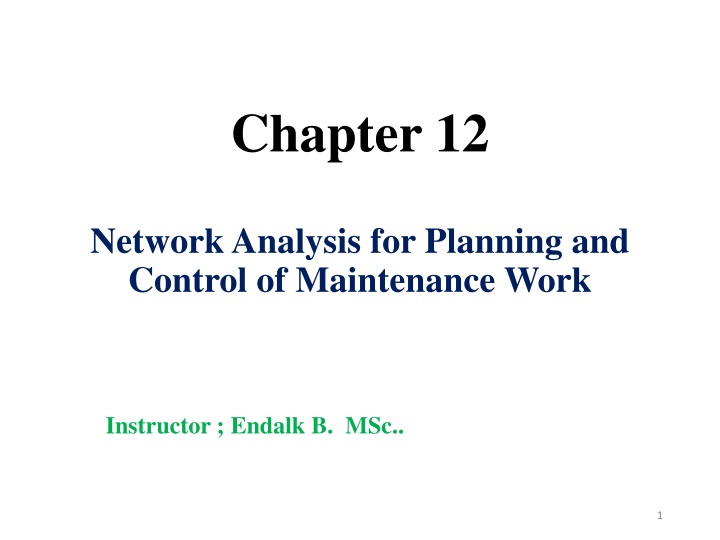
Network Analysis for Maintenance Work Planning
Scheduling is crucial in maintenance work, involving job sequencing, resource matching, and time phasing. Learn about reliable schedules, maintenance schedules at different levels, and elements of sound scheduling for effective maintenance planning and control.
Download Presentation

Please find below an Image/Link to download the presentation.
The content on the website is provided AS IS for your information and personal use only. It may not be sold, licensed, or shared on other websites without obtaining consent from the author. If you encounter any issues during the download, it is possible that the publisher has removed the file from their server.
You are allowed to download the files provided on this website for personal or commercial use, subject to the condition that they are used lawfully. All files are the property of their respective owners.
The content on the website is provided AS IS for your information and personal use only. It may not be sold, licensed, or shared on other websites without obtaining consent from the author.
E N D
Presentation Transcript
Chapter 12 Network Analysis for Planning and Control of Maintenance Work Instructor ; Endalk B. MSc.. 1
Scheduling Is the process by which jobs are matched with resources and sequenced to be executed at a certain points in time. Scheduling deals with the specific time and phasing of planned jobs together with the orders to perform the work, monitoring the work, controlling it, and reporting on job progress. Successful planning needs a feedback from scheduling. 2
Reliable Schedule Must Take Into Consideration A job priority ranking reflecting the criticality of the job. The availability of all materials needed for the work order in the plant. The production should be in master schedule. Realistic estimates and what is likely to happen. Flexibility in the schedule. 3
Maintenance Schedule Can be Prepared at Three Levels (Depend on The Time Horizon) 1. Long-range (master) schedule 2. Weekly schedule 3. Daily schedule 4
Long-Range (master) Schedule Covering a period of 3 months to 1 year, Based on existing maintenance work orders (blanket work order, backlog, PM, anticipated EM). Balancing long-term demand for maintenance work with available resources. Spare parts and material could be identified and ordered in advance. Subject to revision and updating to reflect changes in the plans and maintenance work 5
Weekly Schedule Covering 1 week. Generated from the master schedule. Takes into account current operations schedules and economic considerations. Allow 10% to 15% of the workforce to be available for emergency work. The schedule prepared for the current week and the following one in order to consider the available backlog. The work orders scheduled in this week are sequenced based in priority. CPM and integer programming techniques can be used to generate a schedule. 6
Daily Schedule Covering 1 day. Generated from weekly schedule. Prepared the day before. Interrupted to perform EM. Priorities are used to schedule the jobs. 7
Elements of Sound Scheduling Written work orders that are derived from a well conceived planning process. (Work to be done, methods to be followed, crafts needed, spare parts needed, and priority). Time standards. Information about craft availability for each shift. Stocks of spare parts and information on restocking 8
Elements of Sound Scheduling Information on the availability of special equipment and tools necessary for maintenance work. Access to the plant production schedule and knowledge about when the facilities will be available for service without interrupting production schedule. Well-define priorities for maintenance work. Information about jobs already scheduled that are behind the schedule (backlog). 9
Scheduling Procedures (Steps) Sort backlog work orders by crafts. Arrange orders by priority. Compile a list of completed and carry over jobs. Consider job duration, location, travel distance, and the possibility of combining jobs in the same area. Schedule multi-craft jobs to start at the beginning of every shift. Issue a daily schedule (not for shutdown maintenance). Authorize a supervisor to make work assignments (dispatching). 10
Maintenance Job Priority System Priorities are established to ensure that the most critical work is scheduled first. It is developed under coordination with operations staff. It should be dynamic. It must be updated periodically to reflect changes in operation and maintenance strategies. It typically includes three to ten levels of priority. 11
Scheduling Techniques The objective of the scheduling techniques is to construct a time chart showing: The start and finish for each job. The interdependencies among jobs. The critical jobs that require special attention and effective monitoring 12
Such Techniques are : Modified Gantt chart CPM PERT Integer and stochastic programming 13
Network Graphical interpretation of activities and event, Shows dependency relationships between tasks or activities in a project, Clearly shows tasks that must precede (precedence) or follow (succeeding) other tasks in a logical manner, and Clear representation of plan a powerful tool for planning and controlling project 15
Cont.. 16
Cont. 18
Cont. 19
Cont.. 20
BENEFITS OF CPM / PERT NETWORK Consistent framework for planning, scheduling, monitoring, and controlling project. Shows interdependence of all tasks, work packages, and work units. Helps proper communications between departments and functions. Determines expected project completion date. Identifies so-called critical activities, which can delay the project completion time. 21
Cont.. Identified activities with slacks that can be delayed for specified periods without penalty, or from which resources may be temporarily borrowed Determines the dates on which tasks may be started or must be started if the project is to stay in schedule. Shows which tasks must be coordinated to avoid resource or timing conflicts. Shows which tasks may run in parallel to meet project completion date 22
Solution 24
Cont.. 25
Solution 26
Solution 27
Cont. 28
Cont.. 29
Cont. 32
Example 38
Cont.. 39

